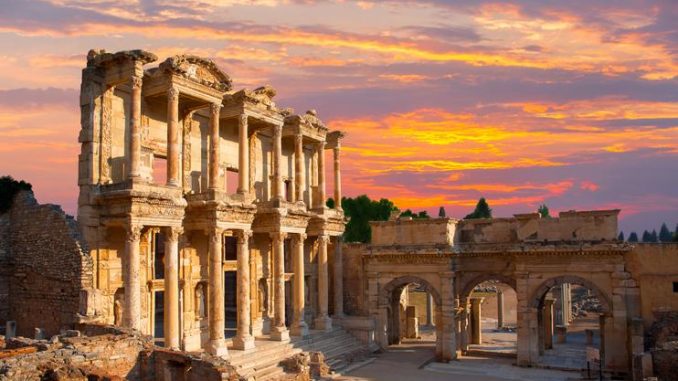
Fabulous Turkey … the destination at the center between East and West cultures. The Meryemana is a major tourist attraction and has a curious history. Tradition holds that the Virgin Mary journeyed to Ephesus with St. John, and is said to have died here. The main building here dates from the Byzantine era (6th century) but its association with the Virgin only began in the 19th century, following the visions of the German nun, Katharina Emmerich, who gave a precise description of the situation and appearance of a house at Ephesus in which she claimed the Virgin had lived and died. In 1891, on the basis of this account, a French priest discovered the ruins of a small church, which had evidently belonged to a monastery and this is now revered as the Virgin’s house. The chapel here is tiny, and be aware that the site is often crowded with tour bus groups. A small wishing well is on site, where it is customary to tie a piece of cloth and make a wish.
Cappadocia is famous for its weird and wonderful natural rock formations and unique historical heritage. One of the best places to see these strange formations is the town of Goreme, which is located among a large number of tuff cones, termed fairy chimneys. The fairy chimneys have been formed as the result of wind and water erosion of two different volcanic layers: A thick layer of tuff (consolidated volcanic ash) covered by a thin layer of basalt that is more resistant to erosion. Due to the ease of carving into the tuff, many of the fairy chimneys at Cappadocia have been hollowed out over the centuries to create houses, churches and storage facilities.
Just south of Antalya, the jaw-dropping mammoth bulk of the Roman Theater of Aspendos celebrates the pomp and ceremony of Marcus Aurelius’ rule. Considered the finest surviving example of a classical age theater still standing in the world, it is one of antiquity’s star attractions. Although the theater is the main reason for a visit here – and for most visitors on a half-day trip from nearby Antalya or Side the theater is all they see – there are more ruins to explore over a vast hilly area if you have time.
Turkey is awash with ancient cities, making it tough to select just one for this list. However, the most popular of these attractions is Ephesus near modern Selcuk. It contains some of the best preserved Greek and Roman ruins in the world and remains a well-trodden part of the tourist trail from nearby resorts such as Kusadasi and Izmir. Some of the most impressive attractions at Ephesus include the Library of Celsus, the Temple of Hadrian and the ancient theatre. Many visitors will explore this city in combination tours with Miletus, Didyma and Priene.
Any tours of Ephesus will take you to this extraordinary archaeological paradise go back to see how the ancient Roman world lived and worked for many years during the Hellenistic Age and The Roman Age. Ephesus is one of many Ancient cities in Turkey that borders the town of Selcuk, south of Izmir and 15 minutes from the coastal town of Kusadasi. Ephesus excursions or any private Ephesus tours will show you one of the seven wonders of the world including the Temple of Artemis which was built in Alexander the Great’s time after the old temple was destroyed by fire by Herostratus and much more. More details on Ephesus private tours.
The Basilica Cistern has been providing Istanbul residents with water since the sixth century when it was ordered built by the Roman Emperor Justinian I. A visit leaves travelers raving about the technology the ancient Romans used to build this architectural wonder that was very advanced for its day. The underground cistern, just a few steps away from the Blue Mosque, was built on the site of a basilica that was constructed in the third century. Known as the Sunken Palace, the cistern can hold up to 2.8 million cubic feet of water. The cistern is one of the locations used in From Russia with Love, a James Bond thriller filmed in 1963.
